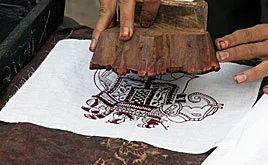Block printing is a relief process made by inking and printing from the top surface of an object. Woodcuts and linocuts are similar relief processes. MoMA has a great introduction to the process.
The process requires a strong paper to withstand the rubbing/burnishing of the surface against the block, but also soft enough to absorb the ink within the grooves. If the surface detail of the block is very fine, a thin, smooth paper would typically be used. That said, if a press is used almost any paper is suitable. For example, watercolor grades with heavy sizing require significant pressure but will produce a crisp print on an etching press.
Japanese papers are typically associated with block printing as they are thin and pliable with little to no sizing, allowing the paper to easily peel away from the block resulting in sharp crisp images. However, as is the theme throughout this site, only by experimenting with different substrates will you find the best choice for your project.



